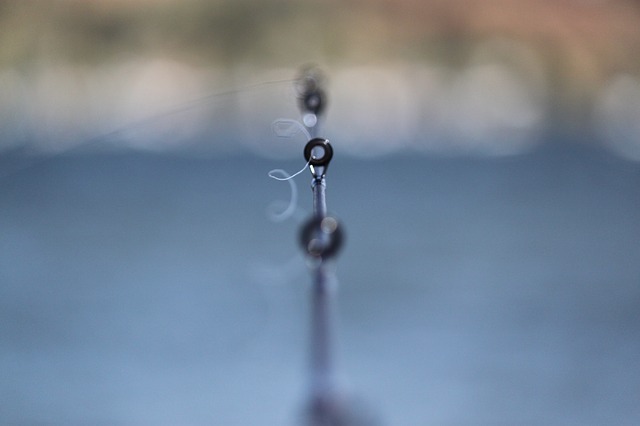Fly Lining Live Bait
Fly lining live bait is the proper term for this style of offshore fishing. I’ll cover the details, and explain the technique in this article.
What Do I mean By Fly Lining Live Bait?
It’s the same idea when fly lining live bait offshore.
The difference is the live bait is pulling the line (along with wind and current) instead of a river or stream pulling the line.
How Do We Get Started?
If you are just getting started, I have great equipment suggestions for you! Check out Equipment and Reviews under the menu headings.
Before I get too far along, always inspect your gear and line at least a few days before your trip. It’s harder to correct these mistakes once out on the ocean.
Ok, we’ll start by getting a plan of what we’re going to need to rig all of our set ups. We’ll concentrate on the fly line set up. We will need 1 good hook. See fish hook sizes for more info here.
Now we’ll feed our line up through each eyelet until we have about the rod’s length of line all the way out. Caution! Watch out for underwraps on your reel. Make sure the line didn’t get underneath and around deeper line on the reel. This is
underwrapping. Also make sure the line goes directly through each eyelet!
Lastly, we need to tie a strong knot from our line to
that hook. I would use either the improved clinch knot, or the palomar knot.
Properly tied either of these knots will do the job. Put your rod in a holder when you’re done and enjoy the trip.
We’re Stopping On Fish, What Do We Do?
The first thing to mention is that we all get excited. Try not to freak out, and push anyone. It’s not going to be received well. There’ll be plenty of time for the action.
Second, listen to the Captain on the speaker and what the deckhands are telling you! Something as simple as throwing your line out early could tangle everyone. Personal boaters don’t have to worry about this as much.
Third, if you’re not sure how to hook your bait read my post on belly hooking. When offshore, bring your rod to the bait tank with you. Pick the liveliest bait you can find, and hook it. Immediately let go of the bait after hooking it. This way your hand won’t do more damage to the bait.
Where Should We Put Our Bait Out?
Before you cast out and if you haven’t already done it, check your drag. Not too loose. Not too tight. Now we need to check the wind. Feel it hitting your face and walk forward. You are now fishing on the correct side of the boat. This way the wind will blow the boat away from our bait. If we fish the other side, our bait and line will go under the boat.
We will effectively have the entire stern (back) and one side of the boat to fish from. It’s really ok to start anywhere along this area as long as the wind is in your face. If the bite is hot, find room to jump in. If it’s a slow bite, start in the furthest corner of the stern and follow your bait around. With wind it’ll naturally go that way.
If you are a beginner, dont worry about casting. You will first put your left thumb on the spool locking it from spinning. Then release the bail. The spool is now held only by your thumb. Lob your bait in the water letting line slip through your thumb. Never take your thumb off the spool! Once your bait is in the water let it swim away from the boat. Never take your
Two very important rules to follow when fly lining live bait!
- Always feel the bait pulling. If you don’t feel it, the line that is underwater (which you can’t see) could be anywhere. Not good! Thumb backwards on your spool, or reel line in if needed to regain slack line.
- If your line is not going straight out from you and the boat, you’re out of position. It’s never as good to be setting the hook on a fish at an angle. Bad things can happen. Like you not catching your fish.
Something’s Got It! The Line Is Flying Out!
The moment we’ve spent so much time preparing for is upon us. Relax just a few seconds longer. Let him eat it. Give him a 4 Mississippi count, then flip the bail, and lift your rod tip up. Don’t jerk it up. Just lift. The speed of the fish will set the hook.
The Fight Is On!
You never know. Until that fish hits the deck of the boat, you just don’t know. I don’t mean what it is. You’ll see that if you fight it long enough. I mean if you’re going to catch it. There are some things we can do to increase our chances.
I always try to be aware of my line location in relation to other fishermen’s line. This way when a fish takes it, I know my line is clear. I at least know if there’s going to be a potential tangle.
With a fish on, always keep your line straight out in front of you just like with our bait. No angles allowed! Follow your fish to keep this position. Look ahead to see if your line is over or under fellow fisherman. Do the tuna dance!
When a large fish is straight down, you’re nearing the end. Now the use of short rhythm pumps, and small reel turns will keep the fish coming. Long pumps in an attempt to gain extra line usually allows the fish time to put his head back down and run. You’ll see what I mean.
When the fish gets close to the top, don’t pull it out of the water. It’s weight on that line will change out of water. Just keep slow pumping and short turns till it comes to gaff. Smaller fish can be hoisted up and over the rail.
Get Out Your Camera!
Get out your camera and capture those moments. Send them to me by email to be featured in future articles at:
Geoff@fishtfight.com
It is my hope that you learned a little something about fly lining live bait. Please take a moment and let me know what you thought of my article by commenting below. Sign up for my newsletter and get notifications on all my articles. Thanks for spending some of your precious time at
FishtFight.com

